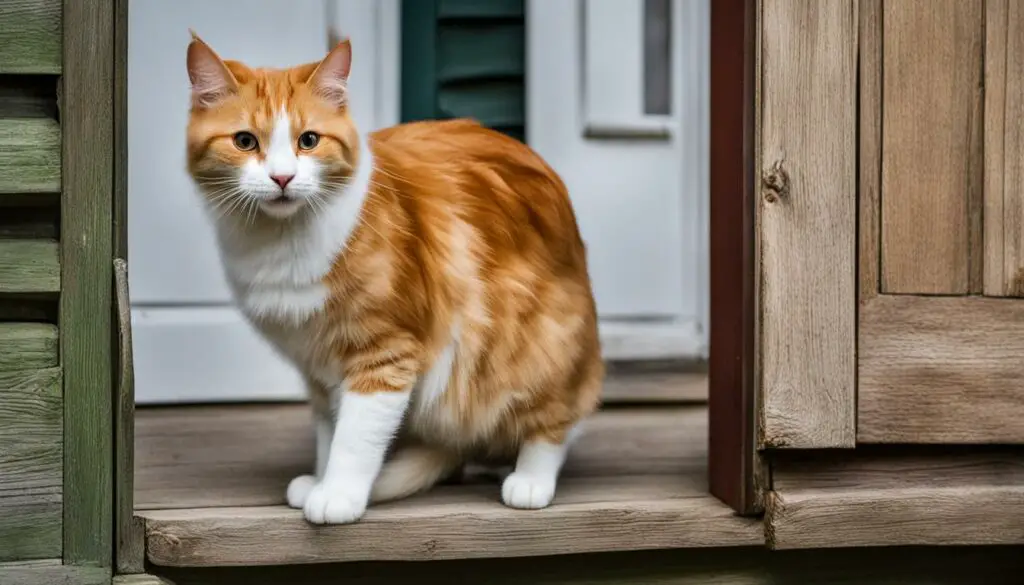Greetings! Today, I want to dive into a fascinating topic that many of us encounter in our daily lives: stray cats meowing at our doors. It’s a common scenario that raises questions and often evokes a mixture of curiosity and concern. But fear not, for I am here to enlighten you on the wonders of these meowing felines and guide you through a comprehensive exploration of their behaviors, needs, and the role we can play in their lives.
As I sat down to gather my thoughts and embark on this journey, an image instantly came to mind. Picture this: a stray cat, standing tall at your doorstep, its eyes filled with an unspoken plea. A meow, soft yet poignant, escapes its mouth, leaving you wondering, “What does this stray cat want? How can I help?”
Well, my friends, this article aims to answer those questions and more. We will uncover the secrets behind the language of meows, delve into the history of our fascinating relationship with cats, and learn how to decode their non-verbal cues. Together, we will understand the reasons why stray cats meow at our doors and discover ways to address their needs. Are you ready? Let’s begin!
Key Takeaways:
- Stray cats meow at our doors to communicate their needs, such as food, shelter, or medical attention.
- Understanding the different vocalizations and body language of cats can help us decipher their messages.
- The bond between humans and cats stretches back thousands of years, evolving from working relationships to cherished companionship.
- Paying attention to the specific characteristics of a stray cat’s meow can help us determine their needs and provide appropriate care.
- Stray cats also communicate through non-verbal cues, including tail movements, ear positions, and body postures.
The Feline Language: Meows, Purrs, and More
Cats, like humans, have their own unique language of communication. One of the most immediate and poignant ways they express themselves is through their voice. Meowing is a versatile sound that can convey a range of needs and emotions, depending on its pitch, volume, and frequency. By understanding the different vocalizations of cats, we can gain insights into what a stray cat may be trying to communicate when they meow at our door. But meowing is not the only form of communication cats use; they also express themselves through body language, which can provide valuable clues about their emotions and intentions.
Meowing is a vocalization that cats predominantly use to communicate with humans. Each meow can hold a different meaning, and by paying attention to its specific characteristics, we can decipher what a stray cat might be trying to convey. For instance, a high-pitched meow with short intervals may indicate hunger, while a low-pitched, drawn-out meow might signal distress or discomfort. Some cats may even develop unique meowing styles or “dialects” that are specific to them. Understanding these variations in meowing can help us respond effectively and provide the appropriate care.
In addition to meowing, cats communicate through body language. They use subtler cues such as tail movements, ear positions, and eye expressions to convey their emotions and intentions. A high, straight-up tail often signifies a happy and confident cat, while a low-hanging or tucked-in tail can indicate fear or submission. Cats also communicate through purring, which is often associated with contentment and relaxation. By observing a stray cat’s body language, we can gain a deeper understanding of their behavior and tailor our interactions to their needs.

Benefits of Understanding Feline Communication:
- Enhanced ability to meet the needs of stray cats
- Improved cat-human bond and communication
- Reduction in misunderstandings and conflicts
- Increased likelihood of providing appropriate care and support
By developing our understanding of feline communication, we can bridge the gap between humans and cats, creating a harmonious environment that benefits both species. Paying attention to their meows and observing their body language allows us to respond to their needs more effectively, whether it be providing food, shelter, or social interaction. Ultimately, by actively engaging with feline communication, we can build stronger bonds with stray cats and contribute to their overall well-being.
The History of Human-Cat Relationship
The bond between humans and cats is a fascinating tale that dates back over 9,000 years. What began as a mutually beneficial relationship founded on cats’ hunting abilities has blossomed into a deep connection and companionship. Cats were first drawn to human communities due to the abundance of prey, and their presence gradually transitioned from purely functional to beloved companions.
Over time, humans began to selectively breed cats, leading to the development of various domestic cat breeds with distinct appearances and personalities. This diversity in breeds reflects the long and complex history of the human-cat bond. Cats have become cherished members of our households, providing comfort, companionship, and affection.
Understanding the history of the human-cat relationship helps us comprehend why stray cats may seek out human companionship or assistance. It sheds light on their innate desire for safety, care, and social interaction. When a stray cat meows at our doors, it is a reminder of the long-standing connection between our species and the unique role that cats play in our lives.
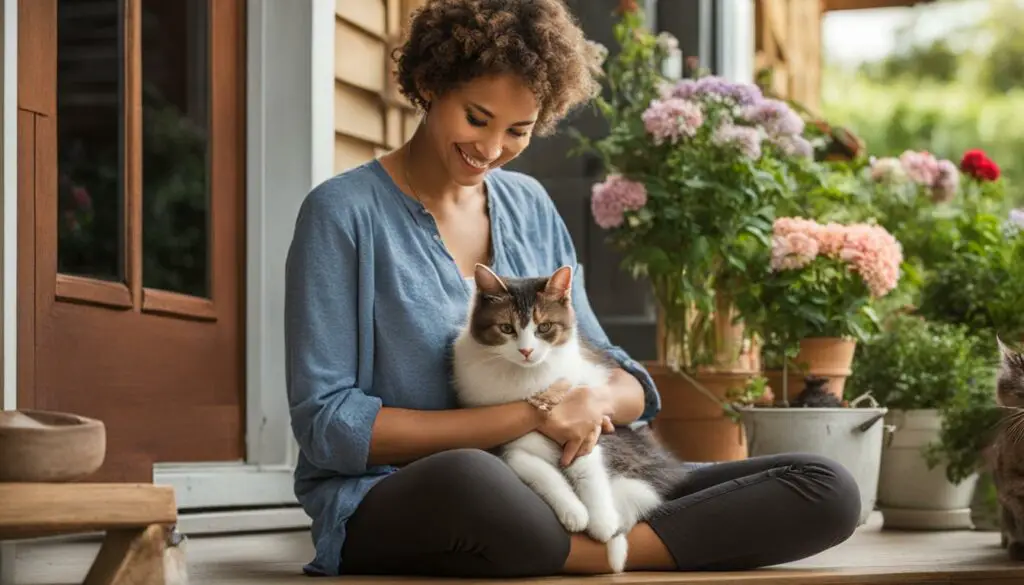
The Role of Cats in Ancient Civilizations
In ancient civilizations, cats were revered for their hunting prowess and were even considered sacred beings. Egyptians worshipped the goddess Bastet, often depicted with the head of a lioness or domestic cat. These feline deities symbolized fertility, protection, and a connection to the divine.
The Renaissance and Beyond
During the Renaissance period, cats were depicted in artwork and literature. They were celebrated for their elegance, independence, and mysterious nature. Cats became popular companions for writers, artists, and intellectuals, renowned for their ability to inspire creativity and contemplation.
Modern-Day Cat Companionship
In modern times, cats continue to captivate our hearts with their loving nature and independent spirit. They have become cherished family members, providing comfort and companionship. The human-cat bond is evident in the millions of households that open their doors and hearts to these remarkable creatures.
Summary
The history of the human-cat relationship spans thousands of years and is marked by mutual respect, admiration, and companionship. From their hunting origins to their revered status in ancient civilizations and their cherished place in modern households, cats have played a significant role in human society. Understanding this history helps us appreciate the bond between humans and cats and respond to the needs of stray cats who meow at our doors.
Decoding the Stray Cat’s Meow
When it comes to stray cats meowing at your door, it’s important to understand that each meow has a unique meaning. By paying attention to the specific characteristics of their vocalizations, such as pitch, volume, and frequency, we can decipher their needs and respond appropriately. Whether they are meowing for food, shelter, attention, or social interaction, their vocalizations serve as a way to communicate with humans.
In order to effectively decode a stray cat’s meow, it’s crucial to listen carefully and observe their behavior. By doing so, we can build a better understanding of their circumstances and provide the necessary care and support. For example, a high-pitched, urgent meow may indicate hunger or a desire for food, while a softer, repetitive meow could signal a need for attention or companionship.
Understanding Stray Cat Sounds:
Stray cats may produce different sounds alongside their meowing, providing further insight into their emotions and intentions. For instance, purring is often associated with contentment and relaxation, while hissing or growling may indicate fear or aggression. By paying attention to these non-verbal vocalizations, we can gain a more comprehensive understanding of the cat’s state of mind.
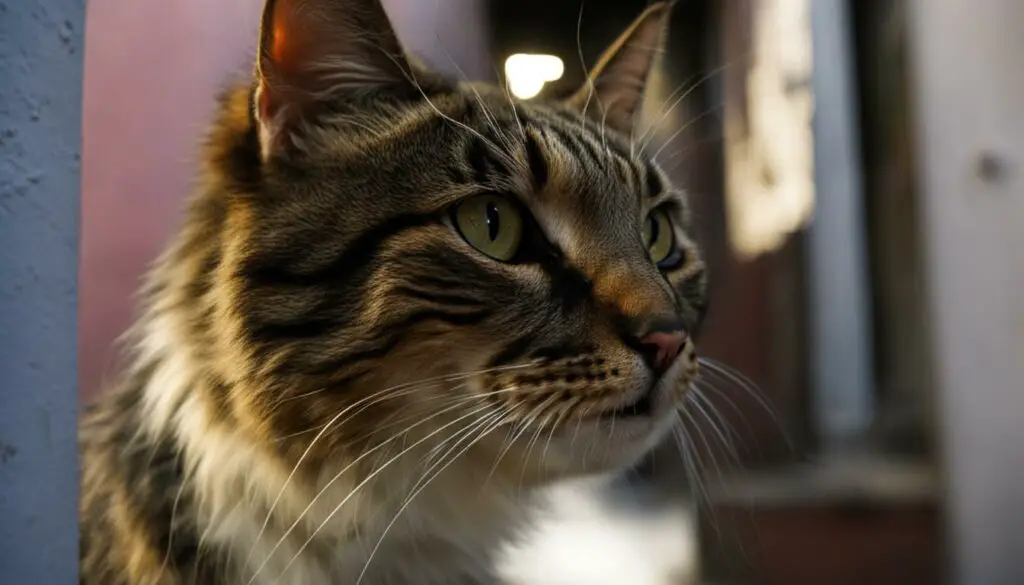
“Meowing can express a desire for food, shelter, attention, or social interaction.”
It’s important to note that the meaning of a stray cat’s meow can also be influenced by their individual personality and past experiences. Some cats may be more vocal than others, while others may rely on non-verbal cues to communicate their needs. By taking the time to decode their meows and understand their unique communication style, we can provide the appropriate care and support for stray cats in our community.
Table: Decoding the Stray Cat’s Meow
| Meow Characteristics | Possible Interpretation |
|---|---|
| High-pitched, urgent meow | Hunger or a desire for food |
| Soft, repetitive meow | Attention or companionship |
| Purring | Contentment and relaxation |
| Hissing or growling | Fear or aggression |
By understanding and responding to a stray cat’s meow, we can provide the necessary care and support, creating a more compassionate and caring community for these vulnerable animals.
The Language of Body: How Cats Communicate Non-Verbally
Cats have a unique way of communicating through non-verbal signals. Their body language provides valuable insights into their emotions and intentions. By understanding these feline communication signals, we can better comprehend a stray cat’s behavior and respond appropriately.
One of the key aspects of a cat’s body language is their tail movements. A high, straight-up tail indicates a happy and confident cat, while a low-hanging or tucked-in tail may indicate fear or submission. Observing a stray cat’s tail can help us gauge their emotional state and adjust our approach accordingly.
In addition to tail movements, a cat’s ears and eyes also play a crucial role in their non-verbal communication. Forward-facing ears indicate attentiveness and curiosity, while flattened or backward-facing ears may indicate aggression or fear. Similarly, dilated pupils can suggest excitement or agitation, while narrowed pupils may indicate aggression or discomfort.
Understanding these non-verbal cues allows us to better interpret a stray cat’s behavior and avoid any potential misunderstandings. It enables us to establish a sense of trust and safety, creating a more positive and productive interaction between humans and stray cats.
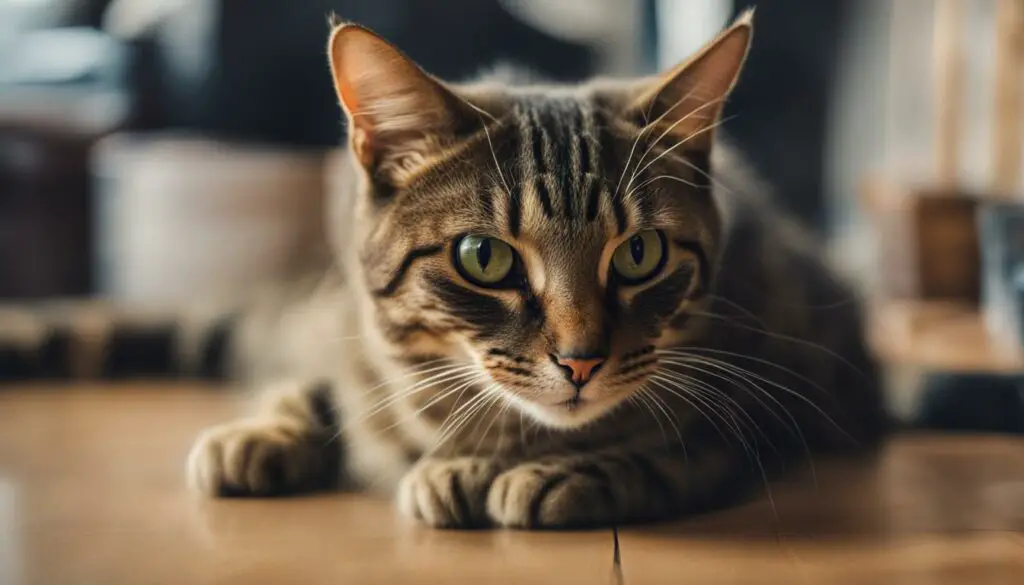
Cat Body Language Signals:
| Body Part | Signal | Meaning |
|---|---|---|
| Tail | High, straight-up tail | Happy and confident |
| Tail | Low-hanging or tucked-in tail | Fear or submission |
| Ears | Forward-facing ears | Attentiveness and curiosity |
| Ears | Flattened or backward-facing ears | Aggression or fear |
| Eyes | Dilated pupils | Excitement or agitation |
| Eyes | Narrowed pupils | Aggression or discomfort |
By paying attention to these feline communication signals, we can create a deeper understanding of a stray cat’s needs and provide the appropriate care and support. Remember, each cat is unique, and their body language may vary. Approach stray cats with patience, empathy, and respect, and let their non-verbal cues guide you in building a positive relationship.
The Common Reasons for Stray Cats Meowing at Your Door
Stray cats meowing at your door can be a common occurrence, and it’s important to understand the reasons behind their vocalizations. This behavior often serves as a means of communication, allowing them to express their needs and seek assistance from humans. So, why do stray cats meow at your door?
Hunger and Thirst
One of the main reasons why a stray cat may meow at your door is hunger or thirst. Stray cats are skilled at associating humans with food, and their meows could be a way of expressing their need for nourishment. Providing food and water stations for stray cats can help address their hunger and thirst, creating a more comfortable environment for them.
Seeking Shelter
Another common reason for stray cats meowing at your door is their search for shelter. Cats have a strong instinct for finding safe and quiet places, especially when they feel threatened. Offering temporary shelters, such as cat houses or insulated boxes, can provide them with a sense of security and protection from the elements.
Medical Attention
Stray cats may also meow at your door if they are in need of medical attention. Living outdoors exposes them to various injuries and illnesses. Excessive meowing, visible signs of injury, or a generally unwell appearance could indicate that a stray cat requires professional help. It’s crucial to approach these situations with caution and seek veterinary care when necessary.
| Reasons for Stray Cats Meowing at Your Door | Solutions |
|---|---|
| Hunger and Thirst | Provide food and water stations |
| Seeking Shelter | Offer temporary shelters |
| Medical Attention | Consult a veterinarian |
Understanding the reasons behind a stray cat’s meowing can help you respond appropriately and provide the care and support they need. By addressing their hunger, offering shelter, and seeking medical attention when necessary, you can contribute to the well-being of stray cats and create a more compassionate community.
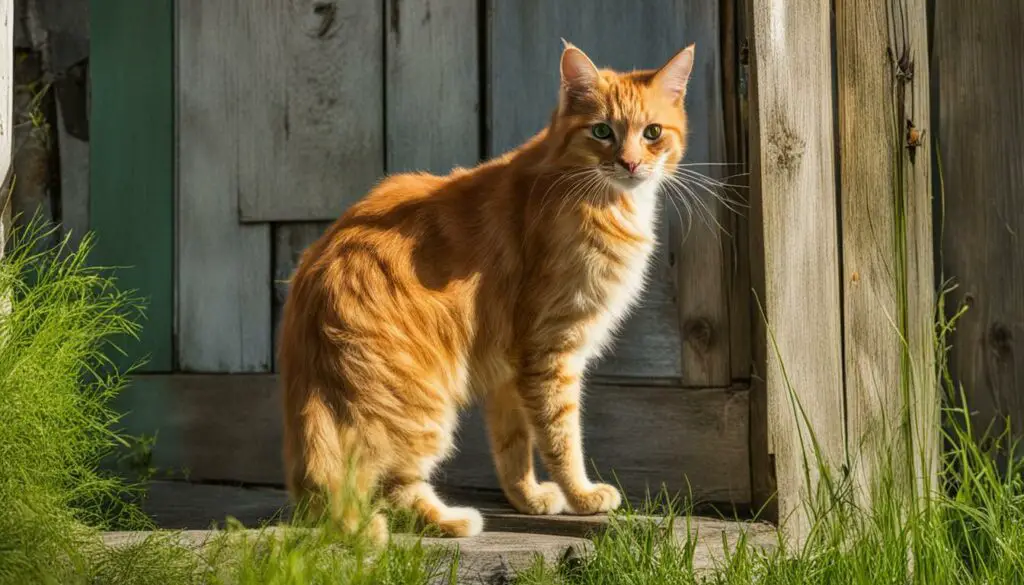
Addressing Hunger and Thirst
When a stray cat meows at your door, it may be a sign that they are hungry or thirsty. Stray cats are often resourceful in associating humans with food, and their vocalizations can be a way of expressing their needs. If you notice that a stray cat appears skinny or has a rough coat, it could be an indication that they haven’t had a good meal in a while or that they are malnourished.
One way to address their hunger and thirst is by providing food and water stations specifically for stray cats. By doing so, you can help alleviate their hunger and create a more comfortable environment for them. Remember to ensure that the food and water are easily accessible, fresh, and replenished regularly.
| Food | Water |
|---|---|
| Provide high-quality cat food that meets their nutritional needs. Avoid feeding them human food or leftovers, as they may contain ingredients that are harmful to cats. | Place bowls of clean, fresh water in a secure location. Consider using a heated water bowl during colder months to prevent freezing. |
| Offer a variety of wet and dry food to cater to their preferences and provide a balanced diet. | Ensure the water bowls are kept clean and free from contaminants to promote good hydration. |
| Monitor their eating habits and adjust the portion sizes accordingly. Overfeeding can lead to obesity and other health issues. | Check the water bowls daily and refill them as needed. |
By addressing hunger and thirst, you can make a significant impact on a stray cat’s well-being. Providing regular meals and clean drinking water helps ensure they have the necessary sustenance to thrive.
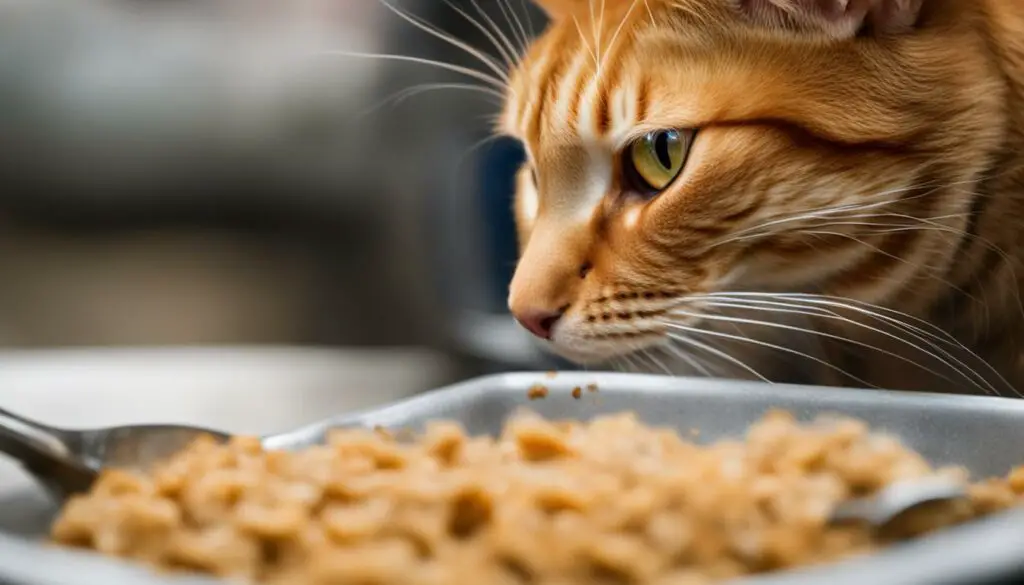
Offering Shelter and Comfort
When a stray cat meows at your door, it may be seeking shelter and a safe place to stay. Cats, being instinctual creatures, look for quiet and secure environments when they feel threatened. By providing temporary shelters, such as cat houses or insulated boxes, you can offer them a sense of security and protection. These shelters should be separate from your own pets to prevent any potential conflicts.
Creating a safe outdoor space for stray cats is essential to their well-being. It ensures they have a comfortable environment where they can find refuge from harsh weather conditions. Adding soft bedding or blankets to their shelters provides extra warmth and comfort during colder months. Remember, a stray cat’s meowing at your door is its way of asking for a place to call home, even if it’s just temporary.
If you encounter a stray cat that appears injured or unwell, it’s important to seek veterinary care. Injuries and diseases are common among stray cats, and getting them the medical attention they need can make a significant difference in their overall health and quality of life. Additionally, ensuring access to clean water and a fresh food source can help meet their basic needs and provide the comfort they seek.
| Benefits of Providing Shelter and Comfort | How to Offer Shelter and Comfort to Stray Cats |
|---|---|
|
|
Addressing Medical Needs
When a stray cat meows at your door, it may be an indication that the cat is in need of medical attention. Living on the streets exposes stray cats to various injuries and illnesses, and their meowing could be a cry for help. It is important to approach these situations with caution and seek veterinary care when necessary. Providing the necessary medical attention to stray cats contributes to their overall well-being and increases their chances of finding a forever home.
Common signs that a stray cat may require medical attention include excessive meowing, visible signs of injury, or a generally unwell appearance. If you notice any of these indicators, it is crucial to take action. By reaching out to local animal services or a veterinarian, you can ensure that the stray cat receives the appropriate care and treatment.
Remember, stray cats rely on our compassion and support, especially when it comes to their health. By addressing their medical needs, we can significantly improve their quality of life and help them on their journey to finding a loving home.
Seek Veterinary Care for Stray Cats
When it comes to stray cats, veterinary care plays a vital role in ensuring their well-being. Stray cats often face a range of health issues, including infections, parasites, injuries, and malnourishment. Seeking veterinary care for stray cats helps diagnose and treat these conditions, giving them a chance at a healthier and happier life.
When taking a stray cat to the veterinarian, it is important to follow proper safety protocols. Stray cats may be frightened or defensive due to their unfamiliar surroundings, so it is essential to approach them calmly and gently. Using a carrier or trap can make the process easier and safer for both you and the cat.
During the veterinary visit, the cat will undergo a thorough examination, receive necessary vaccinations, and be tested for diseases. Depending on their condition, they may also require treatments such as deworming, flea control, or wound care. The veterinarian will provide guidance on how to care for the stray cat post-visit and may recommend additional follow-up appointments or procedures.
By seeking veterinary care for stray cats, we can address their medical needs and give them a chance at a healthier, happier life. Remember, every act of kindness towards stray cats makes a difference, and by providing them with proper medical attention, we contribute to their overall well-being.
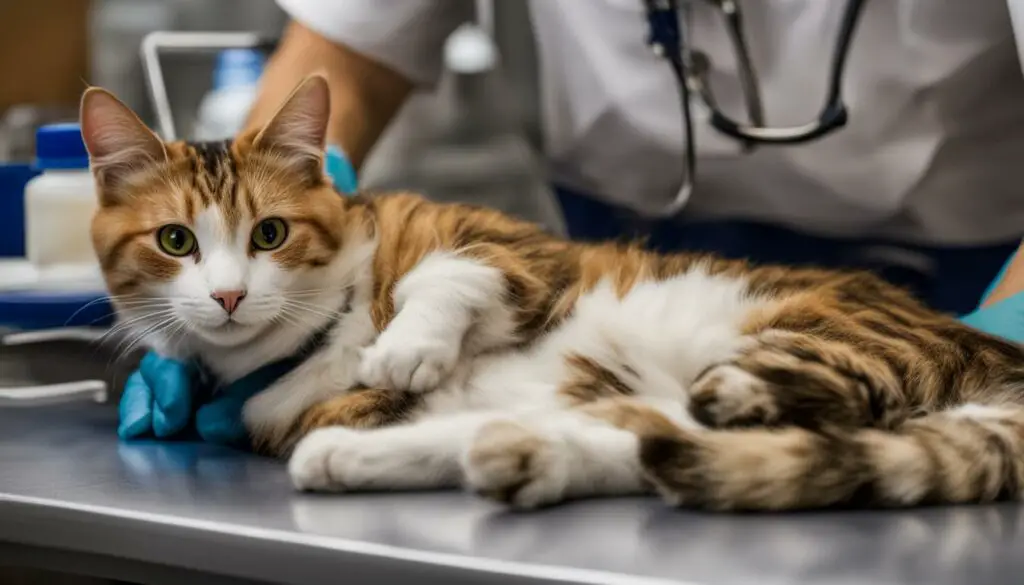
| Benefits of Veterinary Care for Stray Cats | Risks and Challenges |
|---|---|
| 1. Diagnosis and treatment of health issues | 1. Difficulty capturing and transporting stray cats |
| 2. Vaccinations to prevent diseases | 2. Fear and aggression from stray cats during vet visits |
| 3. Testing for diseases and infections | 3. Limited access to veterinary services in some areas |
| 4. Guidance on post-visit care and follow-up | 4. Costs associated with veterinary care |
Seeking Companionship
Stray cats may often meow at your door because they are seeking companionship. Despite the common belief that cats are solitary creatures, they are actually social animals and can form strong bonds with humans. When a stray cat meows at your door and attempts to follow you around, it is a clear sign that they are seeking social interaction and connection.
One behavior that indicates a stray cat’s desire for companionship is rubbing against your legs. This behavior, known as “bunting,” is a natural way for cats to mark their scent and show affection. By reciprocating their displays of affection and providing positive human-cat interactions, we can help fulfill their need for companionship and create a stronger bond.
It is important to approach stray cats with empathy and understanding, as they may have had previous contact with humans and have come to associate us with care and affection. By recognizing their desire for companionship and providing a safe and welcoming environment, we can improve the overall well-being of stray cats and contribute to a more compassionate community.

| Benefits of Companionship for Stray Cats | Benefits of Companionship for Humans |
|---|---|
|
|
“A stray cat’s meow at your door is their way of expressing a desire for companionship. By providing positive human-cat interactions and fulfilling their need for social interaction, we can improve their overall well-being and create a stronger bond.” – Animal Advocate
Understanding the Role of Stray Cats in the Ecosystem
Stray cats play a significant role in the ecosystem, but their presence can have both positive and negative effects. It is crucial to understand the dynamics of the stray cat population and their impact on local wildlife to ensure the well-being of all species.
Stray cats, also known as feral cats, are descendants of domestic cats that live and reproduce in the wild. They often establish territories and hierarchies based on the availability of resources such as food and shelter. This natural behavior can help control populations of pests like rats and mice, contributing to a healthier ecosystem.
However, the presence of stray cats can also pose challenges to local wildlife. They may prey on small mammals, birds, and reptiles, impacting the populations of these species. In some cases, stray cats can become invasive and threaten endangered species. It is important to manage the stray cat population through responsible measures such as neutering and spaying to maintain a balance in the ecosystem.
| Positive Effects | Negative Effects |
|---|---|
| Control of pest populations | Preying on small mammals, birds, and reptiles |
| Reduce the spread of diseases | Threat to endangered species |
| Competition for resources with native wildlife |
Efforts to manage the stray cat population and minimize their impact on local wildlife are essential. Implementing trap-neuter-return (TNR) programs can help control the population size and reduce the hunting behavior of stray cats. By neutering or spaying stray cats, we can prevent the growth of feral colonies and promote a healthier environment for both cats and wildlife. Collaborating with local animal welfare organizations and wildlife conservation groups can provide valuable guidance and resources in managing the stray cat population.
Stray Cat Management Techniques
- Trap-neuter-return (TNR) programs
- Creating awareness about responsible pet ownership
- Educating the community about the importance of spaying and neutering
- Encouraging adoption of stray cats
By understanding the role of stray cats in the ecosystem and implementing effective management strategies, we can create a harmonious coexistence between stray cats, local wildlife, and human communities.

Creating Solutions and Promoting Well-being
When it comes to caring for stray cats, there are several tips and strategies that can help promote their well-being and improve their quality of life. By implementing these solutions, we can contribute to a more compassionate and caring community for stray cats.
Stray Cat Care Tips
1. Provide Food and Water: Setting up food and water stations for stray cats can help alleviate their hunger and thirst. Make sure to provide fresh water daily and offer a balanced diet with cat-friendly food.
2. Temporary Shelters: Creating temporary shelters, such as cat houses or insulated boxes, can offer stray cats a safe and secure place to rest and find protection from the elements.
3. Neutering and Spaying: Promote neutering and spaying programs to manage stray cat populations and prevent the birth of more kittens. This helps reduce the strain on available resources and control the overall population dynamics.
4. Seek Support: Reach out to local animal services or animal welfare organizations for guidance and assistance. They can provide valuable resources, such as trap-neuter-return programs or veterinary care, to help in caring for stray cats.
Stray Cat Adoption
Adopting a stray cat is another way to provide a permanent and loving home. By giving a stray cat a second chance, you not only improve their well-being but also create a strong bond and companionship. Contact local animal shelters or rescue groups to inquire about available stray cats for adoption and the necessary adoption process.
Feral Cat Behavior Modification
For feral cats that are not suitable for indoor adoption, behavior modification programs can help foster more positive interactions with humans and improve their quality of life. These programs focus on gradually socializing feral cats, allowing them to become more comfortable and trusting around humans. Consult with a professional behaviorist or a local animal welfare organization to learn more about feral cat behavior modification programs in your area.
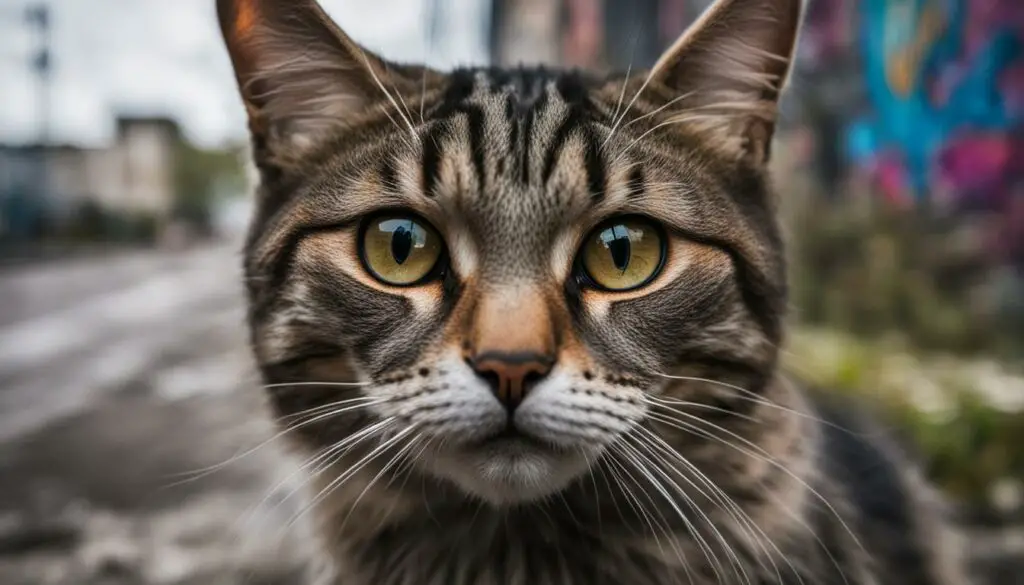
By following these care tips, supporting stray cat adoption, and exploring behavior modification programs, we can make a significant difference in the lives of stray cats. Remember, every small gesture counts when it comes to promoting the well-being of stray cats and creating a more compassionate world for our feline friends.
Conclusion
In conclusion, understanding the behavior of stray cats meowing at your door is essential for creating a compassionate and harmonious environment. By decoding the vocalizations and non-verbal cues of stray cats, we can better respond to their needs and provide the care they require.
Stray cats may meow at your door for various reasons, such as hunger, thirst, seeking shelter, medical attention, or companionship. By addressing these underlying motivations, we can alleviate their suffering and improve their overall well-being.
Creating solutions for stray cats, such as providing food and water stations, offering temporary shelters, promoting neutering and spaying programs, and seeking support from local animal services, can make a significant difference in their lives.
By approaching stray cats with empathy and kindness, recognizing their importance in our lives, we can build a more caring community and ensure the well-being of these vulnerable creatures. So, next time a stray cat meows at your door, remember to listen, understand, and respond with compassion.
FAQ
Why do stray cats meow at my door?
Stray cats meow at your door to communicate various needs such as food, shelter, or medical attention.
How can I understand what a stray cat is trying to communicate through meowing?
Understanding the pitch, volume, and frequency of their meow can help decipher their specific needs and respond accordingly.
Do stray cats communicate through non-verbal cues as well?
Yes, cats also communicate through body language, including tail movements, eye expressions, and grooming habits.
Why do stray cats seek human companionship or assistance?
Stray cats may seek human companionship or assistance due to their previous contact with humans or their need for resources and safety.
How can I provide appropriate care and support for stray cats?
Providing food and water stations, temporary shelters, and seeking guidance from local animal services are some ways to care for stray cats.
What are the common reasons for stray cats meowing at my door?
Stray cats meow at your door to express needs such as hunger, thirst, shelter, medical attention, companionship, or the impact of local wildlife or other cats.
How can I address hunger and thirst for stray cats?
Providing food and water stations can help alleviate hunger and thirst in stray cats.
How can I offer shelter and comfort to stray cats?
Setting up temporary shelters such as cat houses or insulated boxes can provide stray cats with a sense of security and protection.
What should I do if a stray cat appears injured or unwell?
It is important to seek veterinary care if a stray cat appears injured or unwell.
Do stray cats seek social interaction?
Yes, stray cats are social animals and may seek social interaction and companionship, especially if they have had previous contact with humans.
What is the impact of stray cats on the ecosystem?
Stray cats can impact the ecosystem through their population dynamics and interactions with local wildlife.
How can I create solutions and promote the well-being of stray cats?
Providing necessary resources, promoting neutering and spaying, seeking support from local animal services, and promoting adoption and behavior modification programs are ways to promote the well-being of stray cats.

